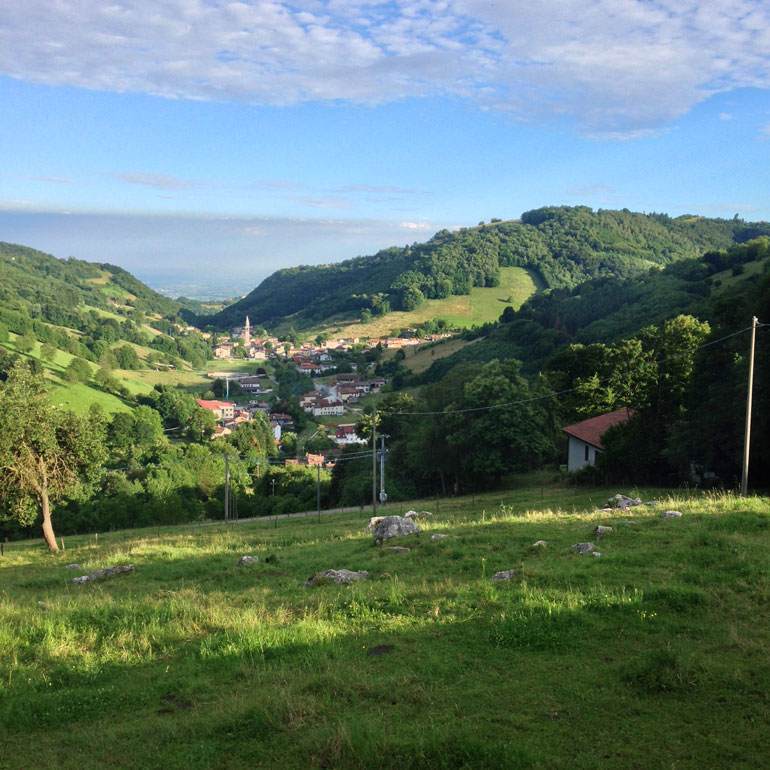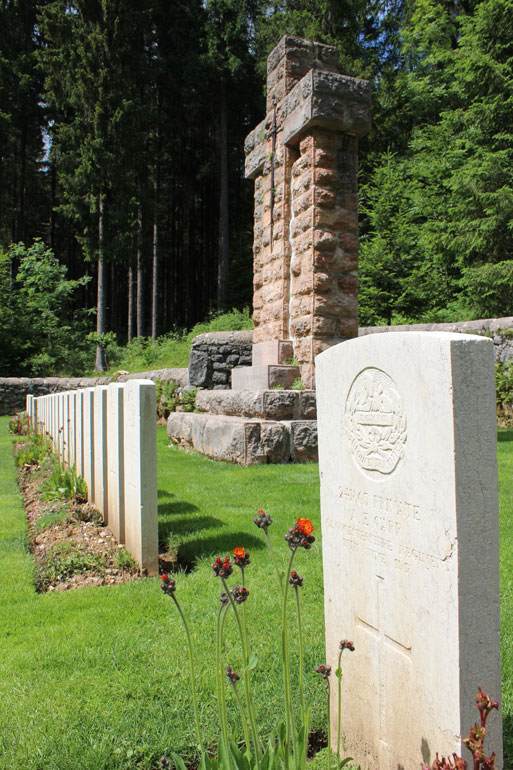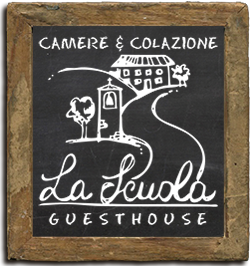Bassano del Grappa, Marostica, Asiago, Breganze, Schio…
… are just few of the places nearby to visit, to discover, to meet for lunch or dinner, for shopping, to tour museums, villas or to simply walk around.
The expanse surrounding Lusiana includes many districts and various types of terrain: rolling hills and jagged cliffs, countryside and towns, streams and forests, interesting rock formations and high peaks, pastures and mountain refuges.
Piazza e Campana are along the way to Asiago, beautiful scenery to where La Scuola awaits. Vitarolo is a small village on the road to Conco and the starting point for peaceful and beautiful walks and drives – by car, motorcycle or bicycle – into the valley pastures, the forests and some splendid towns. Santa Caterina is a small village enveloped in the valley descent toward Marostica. The village church houses an early masterpiece of Jacopo Dal Ponte, and this town holds the fun and flavorful Gnocchi Festival in August.
Covolo, Valle di Sopra, and Valle di Sotto are directly underneath Campana and a must-see route in the magic Valle dei Mulini (Valley of the Mills).
Covolo is a small town with much to see, perfectly located at the departure point for rock climbing walls or for a tour of the intriguing Parco del Sojo, a path lined with 60 works of contemporary art immersed in beautiful, natural surroundings. From here we recommend heading toward the Valle di Sopra and on to the Valle di Sotto, also known as the Valle dei Mulini, where ingenious man made works of art are situated in a magical setting of forests and brooks.
Laverda is the southernmost district, 230 meters above sea level, and across from the stream of the same name.
The mountainous areas of Monte Corno, begin at Cima Larici and Cima Dodici that became part of Lusiana after the dissolution of the Regency of Seven Municipalities and a lovely place to relax and explore.
– Cross-country paths and downhill ski slopes ( lit at night for night skiing) .
– Many mountain refuges where you can purchase local products, salami, butter, cheese – and the famous Asiago cheese that was made for the first time in the mountain refuges of this area.
– Charming unpaved roads with beautiful views, perfect for mountain biking ,trekking, hiking or Nordic walking. The most characteristic of this area is the “Mountain Refuge Path” (“Giro delle Malghe”).
– Enjoy the larch and beech forests where you can hunt for mushrooms (permits available at bars and “osterias” in Lusiana), or just take in the magnificent flora as it changes colors with the seasons.
– The Alpine Botanical Garden includes over 350 species of vegetation that can be explored with a pleasant and very knowledgeable guide.
– Remembrance of the First World War: the English Cemetery of Granezza the French Cemetery and the trenches of the “city of rock”, labyrinth and crevice corridors carved out of the terrain, much of which is man made.
– The “laste“ enclosure made with local marble to contain the herds that stop on the Veterans Memorial Monument (“Monumento ai Caduti”).
A LITTLE FARTHER AHEAD
The location of Lusiana is strategic to take in all the sites and important cities in the Veneto Region. We are located an hour and a half from Venice and from Verona, a little less than that from Padova – famously beautiful cities that need no explanation.
There are some lesser known, must-see places, just a few minutes from La Scuola.
Asiago
Without a doubt the major attraction in the vicinity of La Scuola in Lusiana. Just 20 minutes by car, on a beautiful road framed with beech and birch forests, Asiago is much more than the name of a beloved pressed cheese. Its location, in the middle of the High Plain of 7 Municipalities, surrounded by rolling hills, pastures and chiming bells makes, Asiago a veritable postcard of beauty during any season.
The Veterans Memorial Monument that looms over the center of this small city, the brightly colored houses surrounding it, the large green spaces in summer and the snow covering in winter, the festive Christmas lights and the many pleasant walks to take on pink marble lined paths, the cows at pasture and the backdrop of mountain peaks is both moving and breathtaking. Asiago is ideal for pleasant walks, for downhill and cross-country skiing, and for sampling one of the fantastic restaurants serving local delicacies, or gourmet fare, for shopping (stores are open every Sunday, year-round), to buy locally-produced Asiago cheese DOP, honey and Rigoni organic jams and nut&chocolate cream – so many gifts and souvenirs to buy at the Christmas Market.
And more: tour an exhibit at the museum, Museo Le Carceri, go to the cinema or theater or take part in the many events listed on the Events page.
Marostica
This walled city is known as the “City of Chess” (“Città degli Scacchi”) for its grand live tournaments of held during the second half of September in even-numbered years. Two splendid villages – Santa Caterina and Crosara – are found just 20 minutes from La Scuola, traveling along a street of rolling hills framed with a breathtaking view. Visit the square known as “Piazza degli Scacchi”, and the Lower and Upper Castles at both ends, where the view is truly spectacular, and stroll along the main street, lined with beautiful stores and bakeries. We can offer guests advice on dining in the surrounding areas. Don’t miss the well-stocked antiques market every first Sunday of the month – it lights up the whole center of town.
Bassano del Grappa
Beautiful, elegant and rich in history, Bassano del Grappa is a must-see place in this area. Start at the old bridge, the “Ponte Vecchio”, also known as the Ponte degli Alpini, to take in this city in all of its splendor. Follow the crowds and window shop at beautiful stores and walk around the vibrant squares, Piazza della Libertà and Piazza Garibaldi. Take in the magnificent palaces, great shopping, the spectacular view from the street, Via dei Martiri, and the magical evening lights. Bassano del Grappa was nominated as Alpine capital of the world and is known for its ceramic and paper arts, and of course, as its name indicates, for the production of grappa.
Breganze
Known for producing a high-quality wine of the same name, Red and White Breganze DOC wine is made in the many local DOC vineyards, and also for its famous raisin wine made in January, Torcolato.
A beautiful square sits beneath a high bell tower to form the heart of this charming town, surrounded by rolling hills where cherries and grape vines are cultivated. The world famous company, Diesel, is also headquartered here.
Thiene
This beautiful little city has the great fortune to be located between Vicenza and Trentino, between the plains and the mountains, and has been known since Roman times for its unique commercial, agriculture, and entrepreneurial talent. The city center is rich in art and historic buildings, and a unique site, the Sala Borsa Merci, the main national site for dealings in Asiago butter and cheese. It worth a visit to the pleasant city center and to the Castle of Thiene, an extraordinary example of pre-Palladian villa.
Schio
Known as “little Manchester”, Schio had its greatest development during the rule of the Venetian Empire. Its industrial-based economy and geographic location, with plentiful water, makes it one of the most important production centers for wool (Lanerossi).
Today one can visit its fascinating Industrial Archeology , sites, such as: the former wool producing sites, Lanificio Conte, the Lanificio Francesco Rossi, the great Alta Factory , the Nursery School (“Asilo d’Infanzia”) created for workers’ children and the romantic Jacquard Garden with greenhouse walks and panoramic balcony views.
Also to see in the vicinity of Schio, the beautiful Malo and the Monte di Malo.
Vicenza
A UNESCO cultural heritage site, Vicenza is also known as the City of Palladio (“Città del Palladio”). At least 23 monuments in the historic city center were designed by the great architect, Andrea Palladio, as were well-known villas outside the city walls, including: the Basilica Palladiana, the Teatro Olimpico, the Palazzo Valmarana, and the Villa La Rotonda.This beautiful city is rich and hard-working, and also known as the Italian capital of gold craftsmanship.
Just 45 minutes from La Scuola is a must-see trip among elegant, historic buildings (Piazza dei Signori, Piazza delle Erbe), lively streets in the city center and impressive bridges. Vicenza is also known for its high culture, and often hosts major exhibits and theater performances.
The Venetian Villas
There are many Venetian Villas in the Vicenza province to see, testimony to the agricultural investment and grand development of the nobility of the Venetian Empire (“la Serenissima”). Sumptuous works of art and great architecture abound, including the designs of Andrea Palladio. We recommend taking the roads near La Scuola if you would like to visit this area and such sites as the Villa Godi Malinverni, Villa Trissino Trettenero, and the Villa Angarano Bianchi Michiel.










